Desa BY70CEB, BY35CEB, BY150CEB, BY100CEB User Manual
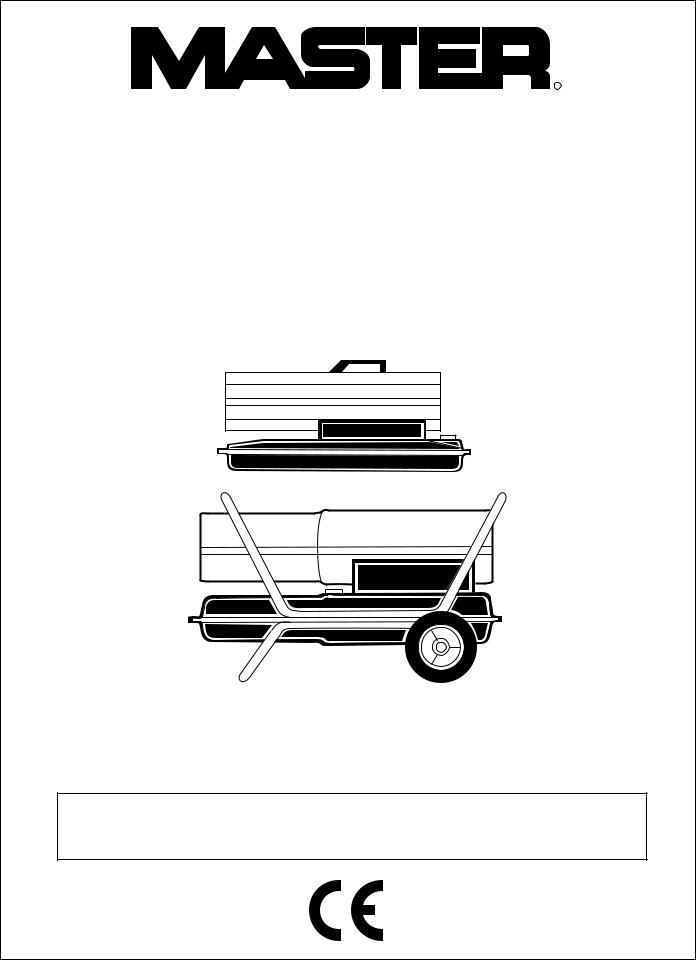
R
PORTABLE
FORCED
AIR HEATERS
OWNER’S MANUAL
Heater Sizes: 35,000 70,000 100,000 150,000 Btu/Hr
Models: BY35CEB, BY70CEB, BY100CEB, and BY150CEB
IMPORTANT: Read and understand this manual before assembling, starting or servicing heater. Improper use of heater can cause serious injury. Keep this manual for future reference.
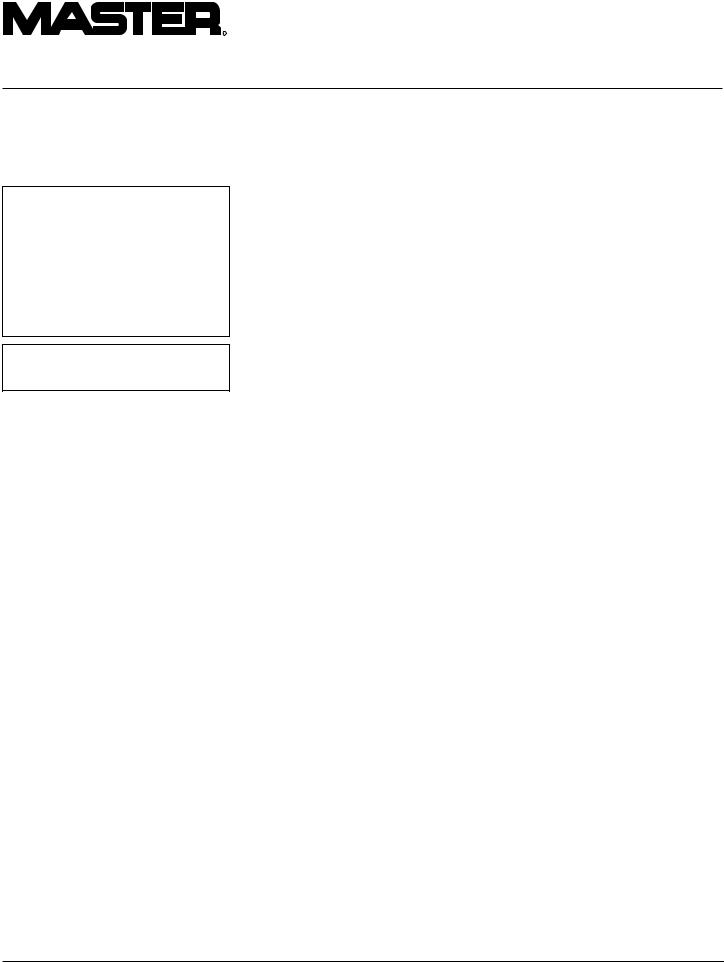
R
PORTABLE FORCED AIR HEATERS
SAFETY
INFORMATION
 WARNINGS
WARNINGS
IMPORTANT: Read this Owner’s Manual carefully and completely before trying to assemble, operate, or service this heater. Improper use of this heater can cause serious injury or death from burns, fire, explosion, electrical shock, and carbon monoxide poisoning.
 DANGER: Carbon monoxide poisoning may lead to death!
DANGER: Carbon monoxide poisoning may lead to death!
Carbon Monoxide Poisoning: Early signs of carbon monoxide poisoning resemble the flu, with headaches, dizziness, and/or nausea. If you have these signs, the heater may not be working properly. Get fresh air at once! Have heater serviced. Some people are more affected by carbon monoxide than others. These include pregnant women, persons with heart or lung disease or anemia, those under the influence of alcohol, and those at high altitudes.
Make certain you read and understand all Warnings. Keep this manual for reference. It is your guide to safe and proper operation of this heater.
•Use only kerosene or No. 1 fuel oil to avoid risk of fire or explosion. Never use gasoline, naphtha, paint thinners, alcohol, or other highly flammable fuels.
•Fueling
a)Personnel involved with fueling shall be qualified and thoroughly familiar
with the manufacturer's instructions and applicable regulations regarding the safe fueling of heating units. b)Only the type of fuel specified on the
heater's data plate shall be used.
c)All flame, including the pilot light, if any, shall be extinguished and the heater allowed to cool, prior to fueling.
d)During fueling, all fuel lines and fuelline connections shall be inspected for leaks. Any leaks shall be repaired prior to returning the heater to service.
e)At no time shall more than one day's supply of heater fuel be stored inside a building in the vicinity of the heater. Bulk fuel storage shall be outside the structure.
f)All fuel storage shall be located a minimum of 762cm (25 feet) from heaters, torches, welding equipment, and similar sources of ignition (exception: the fuel reservoir integral with the heater unit).
g)Whenever possible, fuel storage shall be confined to areas where floor penetrations do not permit fuel to drip onto or be ignited by a fire at lower elevation.
h)Fuel storage shall be in accordance with the authority having jurisdiction.
•Never use heater where gasoline, paint thinner, or other highly flammable vapors are present.
•Follow all local ordinances and codes when using heater.
•Heaters used in the vicinity of tarpaulins, canvas, or similar enclosure materials shall be located a safe distance from such materials. The recommended minimum safe distance is 304.8cm (10 feet). It is further recommended that these enclosure materials be of a fire retardant nature. These enclosure materials shall be securely fastened to prevent them from igniting or from upsetting the heater due to wind action.
•Use only in well-vented areas. Before using heater, provide at least a 2800 square cm (three-square-foot) opening of fresh, outside air for each 100,000 Btu/Hr of rating.
•Use only in places free of flammable vapors or high dust content.
•Use only the electrical voltage and frequency specified on model plate.
•Use only a three-prong, grounded extension cord.
•Minimum heater clearances from combustibles:
Outlet: 250 cm (8 Ft.)
Sides, Top, and Rear: 125 cm (4 Ft.)
• Locate heater on a stable and level surface if heater is hot or running or a fire may occur.
•When moving or storing heater, keep heater in a level position or fuel spillage may occur.
•Keep children and animals away from heater.
•Unplug heater when not in use.
•When used with thermostat, heater may start anytime.
•Never use heater in living or sleeping areas.
•Never block air inlet (rear) or air outlet (front) of heater.
•Never move, handle, refuel, or service a hot, operating, or plugged-in heater.
•Never attach duct work to front or rear of heater.
2 |
103618 |

OWNER’S MANUAL
PRODUCT
IDENTIFICATION
Hot Air Outlet
Handle
Upper Shell 
Fan Guard
Lower Shell
Air Filter
End Cover
Fuel Tank
|
Fuel Cap |
Side Cover |
|
ON/OFF Switch |
|
Flame-Out |
Power |
Control Reset |
Cord |
Button |
|
Figure 1 - 35/70,000 Btu/Hr Models |
|
Hot Air |
|
Outlet |
|
|
Upper Shell |
Lower |
|
Shell |
|
|
Fan Guard |
Fuel Cap |
Fuel Tank |
|
|
Side Cover |
|
Flame-Out Control |
|
Reset Button |
Power Cord |
ON/OFF Switch
Figure 2 - 100/150,000 Btu/Hr Models
UNPACKING
1.Remove all packing items applied to heater for shipment.
2.Remove all items from carton.
3.Check items for any shipping damage. If heater is damaged, promptly inform dealer where you bought heater.
103618 |
3 |

R
PORTABLE FORCED AIR HEATERS
ASSEMBLY
(FOR 100,000 AND 150,000 BTU/HR MODELS ONLY)
These models are furnished with wheels and handles. Wheels, handles, and the mounting hardware are found in the shipping carton.
Tools Needed
•Medium Phillips Screwdriver
•3/8" Open or Adjustable Wrench
•Hammer
1.Slide axle through wheel support frame. Install wheels on axle.
IMPORTANT: When installing wheels, point extended hub of wheels toward wheel support frame (see Figure 3).
2.Place cap nuts on axle ends. Gently tap with hammer to secure.
3.Place heater on wheel support frame. Make sure air inlet end (rear) of heater is over wheels. Line up holes on fuel tank flange with holes on wheel support frame.
4.Place front handle and rear handle on top of fuel tank flange. Insert screws through handles, fuel tank flange, and wheel support frame. Attach nut finger tight after each screw is inserted.
5.After all screws are inserted, tighten nuts firmly.
Front Handle
FUELS
 WARNING: Use only kerosene or No. 1 fuel oil to avoid risk of fire or explosion. Never use gasoline, naphtha, paint thinners, alcohol or other highly flammable fuels.
WARNING: Use only kerosene or No. 1 fuel oil to avoid risk of fire or explosion. Never use gasoline, naphtha, paint thinners, alcohol or other highly flammable fuels.
Do not use heavy fuels such as No. 2 fuel oil or No. 2 Diesel. Using heavy fuels will result in:
•clogged fuel filter and nozzle
•carbon build up on spark plug
•use of non-toxic anti-icer in fuel during very cold weather
IMPORTANT: Use a KEROSENE ONLY container. Be sure storage container is clean. Foreign matter such as rust, dirt, or water will cause the flame-out control to shut down heater. Foreign matter may also require you to clean fuel system often.
Screw
Hot Air
Outlet Rear
Handle
Fuel Tank |
Air Inlet |
|
|
Flange |
|
Wheel
Support
Frame
Wheel |
Nut |
|
Cap Nut |
|
Extended |
|
Axle |
Hub |
VENTILATION
 WARNING: Follow the minimum fresh, outside air ventilation requirements. If proper fresh, outside air ventilation is not provided, carbon monoxide poisoning can occur. Provide proper fresh, outside air ventilation before running heater.
WARNING: Follow the minimum fresh, outside air ventilation requirements. If proper fresh, outside air ventilation is not provided, carbon monoxide poisoning can occur. Provide proper fresh, outside air ventilation before running heater.
Provide a fresh air opening of at least 2800 square cm (three square feet) for each 100,000 Btu/Hr rating. Provide extra fresh air if more heaters are being used.
Example: A 150,000 Btu/Hr heater requires one of the following:
•a two-car garage door raised 15 cm (six inches)
•a single-car garage door raised 23 cm (nine inches)
•two, 76 cm (thirty-inch) windows raised 31 cm (twelve inches)
Figure 3 - Wheel and Handle Assembly, 100/150,000 Btu/Hr Models Only
4 |
103618 |
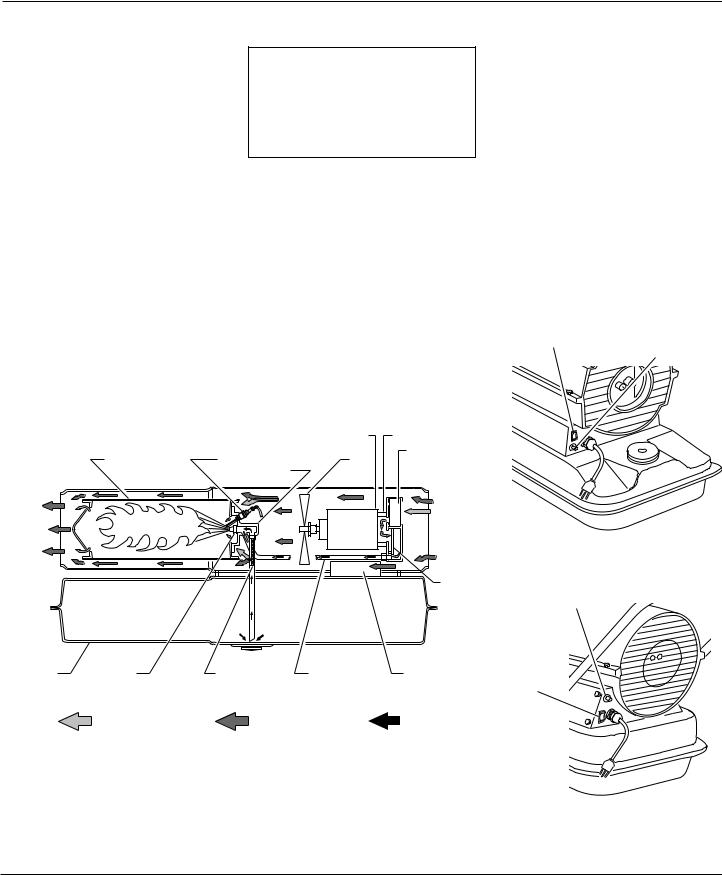
OWNER’S MANUAL
THEORY OF
OPERATION
The Fuel System: The air pump forces air through the air line. The air is then pushed through the burner head nozzle. This air causes fuel to lift from the tank. A fine mist of fuel is sprayed into the combustion chamber.
The Air System: The motor turns the fan. The fan pushes air into and around the combustion chamber. This air is heated and provides a stream of clean, hot air.
The Ignition System: The electronic ignitor sends voltage to the spark plug. The spark plug ignites the fuel and air mixture.
The Flame-Out Control System: This system causes the heater to shut down if the flame goes out.
OPERATION
 WARNING: Review and understand the warnings in the Safety Information Section. They are needed to safely operate this heater. Follow all local codes when using this heater.
WARNING: Review and understand the warnings in the Safety Information Section. They are needed to safely operate this heater. Follow all local codes when using this heater.
To Start Heater
1.Follow all ventilation and safety information.
2.Fill fuel tank with kerosene or No. 1 fuel oil.
3.Attach fuel cap.
4.Plug power cord of heater into standard 230 volt/50 hertz, grounded (earthed) outlet. Use an extension cord if needed. Use only a three-prong, grounded (earthed) extension cord.
Extension Cord Wire Size
Requirements
Up to 30.5 meters (100 feet) long, use 1.0 mm2 (16 AWG) conductor.
30.6 to 61 meters (101 to 200 feet) long, use 1.5 mm2 (14 AWG) conductor.
Push ON/OFF switch to ON and heater should start. If heater does not start, press flame-out control reset button (see Figures 5 and 6).
To Stop Heater
1.Push ON/OFF switch to OFF.
To Restart Heater
1.Wait 2 minutes after stopping heater.
2.Repeat steps under To Start Heater.
ON/OFF Switch |
Flame-Out Control |
|
Reset Button |
|
|
|
|
Motor |
Air Pump |
|
|
Combustion |
Spark |
|
Fan |
Intake Air |
|
|
Chamber |
Plug |
Burner |
Filter |
|
|
|
|
|
Head |
|
|
|
Clean |
|
|
|
|
Cool |
|
Heated |
|
|
|
|
|
|
|
|
|
|
Air In |
|
|
Air Out |
|
|
|
|
Figure 5 - Flame-Out Control Reset Button, |
|
|
|
|
|
|
||
|
|
|
|
|
|
|
|
|
|
|
|
|
35/70,000 Btu/Hr |
|
|
|
|
|
Output |
|
|
|
|
|
|
Air Filter Flame-Out Control |
|
|
|
|
|
|
|
Reset Button |
Fuel |
Nozzle |
Fuel |
|
Air Line |
Electronic |
ON/OFF |
Tank |
Filter |
|
To Burner |
Ignitor |
||
|
|
Switch |
||||
|
|
|
|
|
|
|
|
Air For Fuel |
|
Air For |
|
|
|
|
|
Combustion |
Fuel |
|
||
|
System |
|
|
|||
|
|
And Heating |
|
|
||
|
|
|
|
|
||
Figure 4 - Cross Section Operational View
Figure 6 - Flame-Out Control Reset
Button, 100/150,000 Btu/Hr
103618 |
5 |
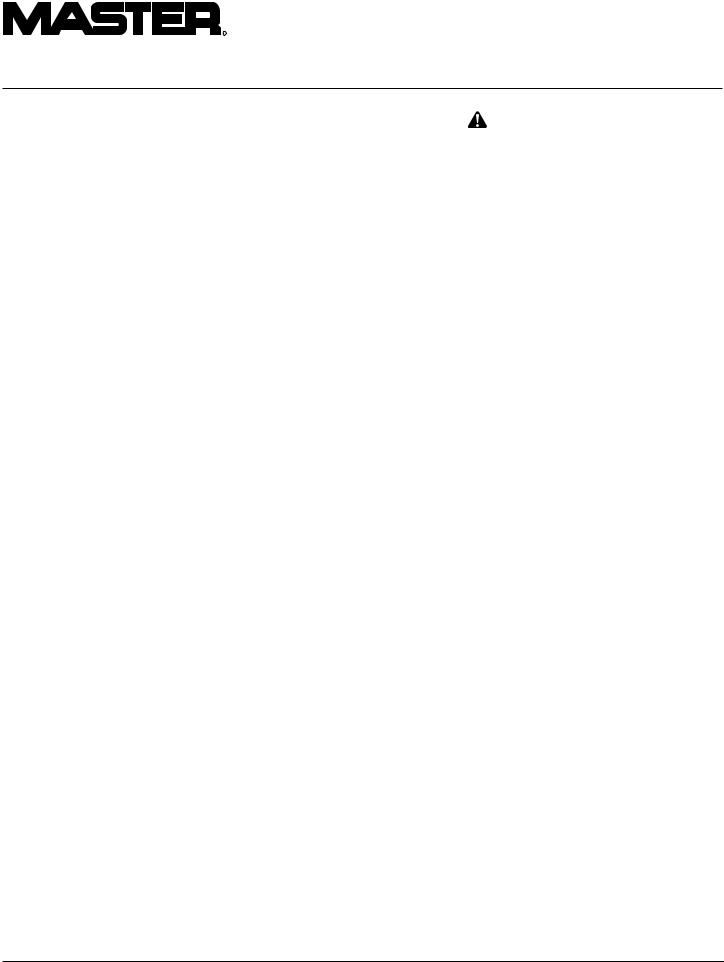
R
PORTABLE FORCED AIR HEATERS
STORING,
TRANSPORTING, OR SHIPPING
Note: If shipping, transport companies require fuel tanks to be empty.
1.Drain fuel tank. Note: Some models have drain plug on underside of fuel tank. If so, remove drain plug to drain all fuel. If heater does not have drain plug, drain fuel through fuel cap opening. Be sure all fuel is removed.
2.Replace drain plug if provided.
3.If any debris is noted in old fuel, add 1 or 2 quarts of clean kerosene to tank, stir, and drain again. This will prevent excess debris from clogging filters during future use.
4.Replace fuel cap or drain plug. Properly dispose of old and dirty fuel. Check with local automotive service stations that recycle oil.
5.If storing, store heater in dry place. Make sure storage place is free of dust and corrosive fumes.
IMPORTANT: Do not store kerosene over summer months for use during next heating season. Using old fuel could damage heater.
PREVENTATIVE |
WARNING: Never service heater |
|
MAINTENANCE |
||
while it is plugged in, operating, or hot. |
||
SCHEDULE |
Severe burns and electrical shock can |
|
occur. |
||
|
|
Item |
How Often |
How To |
Fuel tank |
Flush every 150-200 hours of |
See Storing, Transporting, or |
|
operation or as needed. |
Shipping. |
Air output and |
Replace every 500 hours of |
See Air Output, Air Intake, and Lint |
lint filters |
operation or once a year. |
Filters, page 10. |
Air intake filter |
Wash and dry with soap and |
See Air Output, Air Intake, and Lint |
|
water every 500 hours of op- |
Filters, page 10. |
|
eration or as needed. |
|
Fuel filter |
Clean twice a heating season |
See Fuel Filter, page 8. |
|
or as needed. |
|
Spark plug |
Clean and regap every 600 |
See Spark Plug, page 9. |
|
hours operation or replace as |
|
|
needed. |
|
Fan blades |
Clean every season or as |
See Fan, page 13. |
|
needed. |
|
Motor |
Not required/permanently lu- |
|
|
bricated |
|
6 |
103618 |
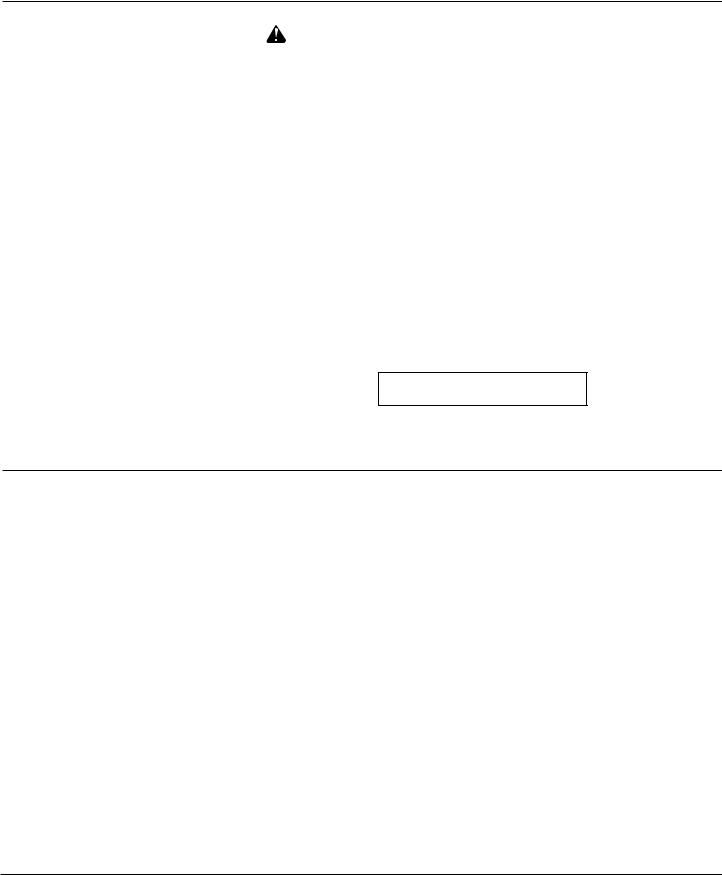
OWNER’S MANUAL
TROUBLESHOOTING |
|
WARNING: Never service heater while it is plugged in, operating, or |
||
|
|
|||
|
|
hot. Severe burns and electrical shock can occur. |
||
|
|
|
||
OBSERVED FAULT |
POSSIBLE CAUSE |
REMEDY |
||
Heater ignites, but flame-out control shuts |
1. |
Wrong pump pressure |
1. |
See Pump Pressure Adjustment, page 10. |
off heater after a short period of time. |
2. |
Dirty air output, air intake, and lint filters |
2. |
See Air Output, Air Intake and Lint Fil- |
|
|
|
|
ters, page 10. |
|
3. |
Dirty fuel filter |
3. |
See Fuel Filter, page 8. |
|
4. |
Dirt in nozzle |
4. |
See Nozzle, page 11. |
|
5. |
Dirty photocell lens |
5. |
Clean photocell lens. |
|
6. |
Bad flame-out control |
6. |
Replace flame-out control. |
|
|
|
|
|
Heater will not ignite, but motor runs for a |
1. |
Wrong pump pressure |
1. |
See Pump Pressure Adjustment, page 10. |
short period of time. |
2. |
Carbon deposits on spark plug and/or |
2. |
See Spark Plug, page 9. |
|
|
improper gap |
|
|
|
3. |
Dirty fuel filter |
3. |
See Fuel Filter, page 8. |
|
4. |
Dirt in nozzle |
4. |
See Nozzle, page 11. |
|
5. |
Water in fuel tank |
5. |
Drain and flush fuel tank with clean |
|
|
|
|
kerosene. See Storing, Transporting, or |
|
|
|
|
Shipping, page 6. |
 WARNING: High voltage!
WARNING: High voltage!
6.Electronic ignitor not grounded (earthed)
7.Bad electronic ignitor
6.Make sure electronic ignitor mounting is tight.
7.Replace electronic ignitor.
Motor does not start when heater is plugged 1. |
Flame-out control not reset |
1. |
Reset flame-out control button, see Fig- |
in, fan rotates slowly or does not turn. |
|
|
ures 5 and 6, page 5. |
2. |
Binding pump rotor |
2. |
If fan is hard to turn, see Pump Rotor, |
|
|
|
page 12. |
103618 |
7 |
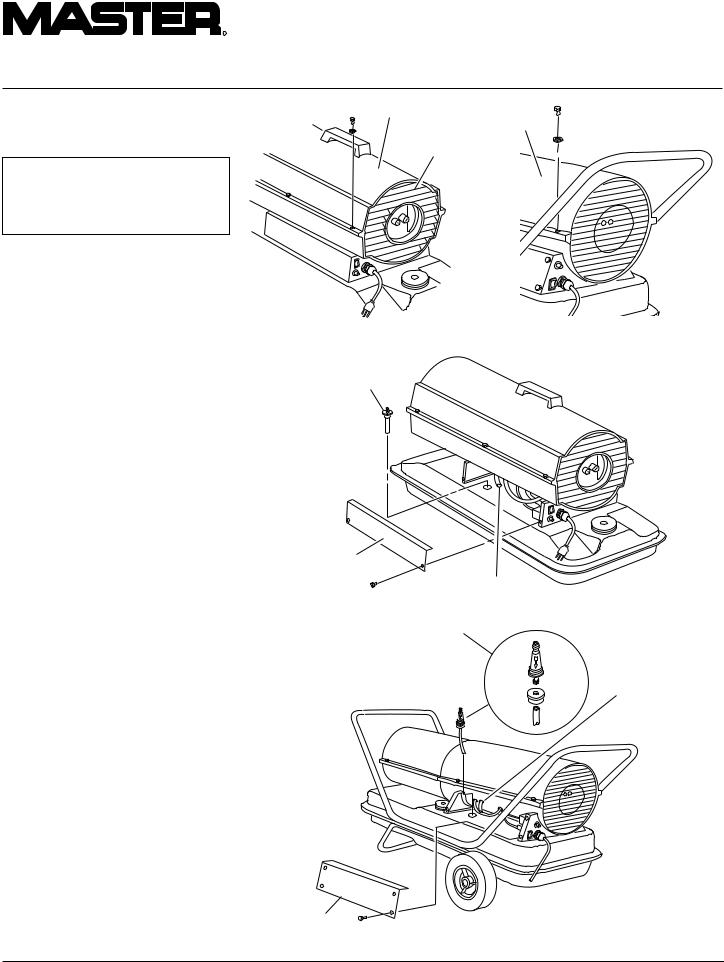
R
PORTABLE FORCED AIR HEATERS
SERVICE
PROCEDURES
 WARNING: Never service heater while it is plugged in, operating, or hot. Severe burns and electrical shock can occur.
WARNING: Never service heater while it is plugged in, operating, or hot. Severe burns and electrical shock can occur.
Upper Shell Removal
1.Remove screws and lock washers along each side of heater using 5/16" nutdriver. These screws attach upper and lower shells together.
2.Lift upper shell off.
3.Remove fan guard.
Fuel Filter
(35/70,000 Btu/Hr Models)
1.Remove side cover screws using 5/16" nut-driver.
2.Remove side cover.
3.Pull rubber fuel line off fuel filter neck.
4.Carefully pry bushing and fuel filter out of fuel tank.
5.Wash fuel filter with clean fuel and replace in tank.
6.Attach rubber fuel line to fuel filter neck.
7.Replace side cover.
Fuel Filter
Upper Shell |
Upper |
|
Shell |
|
Fan |
|
Guard |
 Fan
Fan
Guard
Figure 7 - Upper Shell Removal, 35/70,000 |
Figure 8 - Upper Shell Removal, 100/ |
Btu/Hr Models |
150,000 Btu/Hr Models |
Fuel Filter |
|
Side Cover
Fuel Line
Figure 9 - Fuel Filter Removal, 35/70,000 Btu/Hr Models
(100/150,000 Btu/Hr Models)
1.Remove side cover screws using 5/16" nut-driver.
2.Remove side cover.
3.Pull upper fuel line off fuel filter neck.
4.Carefully pry bushing, lower fuel line, and fuel filter out of fuel tank.
5.Wash fuel filter with clean fuel and replace in tank.
6.Attach upper fuel line to fuel filter neck.
7.Replace side cover.
Fuel Filter, Bushing,
and Lower Fuel Line
Upper Fuel
Line
Side Cover
Figure 10 - Fuel Filter Removal, 100/150,000 Btu/Hr Models
8 |
103618 |
